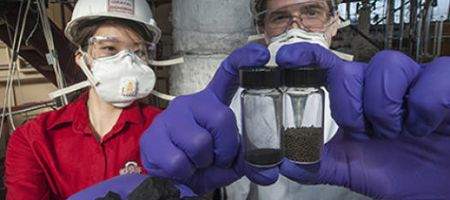A new form of clean coal technology is ready for large-scale testing, following successful research trials at Ohio State University.

For 203 continuous hours, the Coal-Direct Chemical Looping (CDCL)combustion unit produced heat from coal, while capturing 99 percent of the carbon dioxide produced in the reaction.
“In the simplest sense, combustion is a chemical reaction that consumes oxygen and produces heat,” says professor Liang-Shih Fan of Ohio State’s Clean Coal Research Laboratory.
“Unfortunately, it also produces carbon dioxide, which is difficult to capture and bad for the environment. So we found a way to release the heat without burning. We carefully control the chemical reaction so that the coal never burns — it is consumed chemically, and the carbon dioxide is entirely contained inside the reactor.”
The key to the technology is the use of tiny iron oxide beads to carry oxygen to the fuel – powdered coal – and trigger the chemical reaction.
The coal and iron oxide are heated to high temperatures, where the materials react with each other. Carbon from the coal binds with the oxygen from the iron oxide and creates carbon dioxide, which rises into a chamber where it is captured. Hot iron and coal ash are left behind.
Because the iron beads are so much bigger than the coal ash, they are easily separated and delivered to a chamber where the heat energy would normally be harnessed for electricity. The coal ash is removed from the system.
The carbon dioxide is separated and can be recycled or sequestered for storage. The iron beads are exposed to air inside the reactor, so that they become re-oxidized be used again. The beads can be re-used almost indefinitely, or recycled.
“In the two years we’ve been running the sub-pilot plants, our CDCL and SCL units have achieved a combined 830 operating hours, which clearly demonstrates the reliability and operability of our design,” says Fan.
At any one time, the units each produce about 25 thermal kilowatts. Alarger-scale pilot plant is under construction at the US Department of Energy’s National Carbon Capture Center in Wilsonville, Alabama. Set to begin operations later this year, it will produce 250 thermal kilowatts.
“The commercial-scale CDCL plant could really promote our energy independence,” says research associate Dawei Wang. “Not only can we use America’s natural resources such as Ohio coal, but we can keep our air clean and spur the economy with jobs.”






